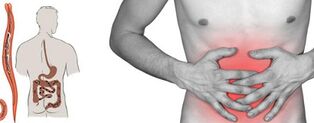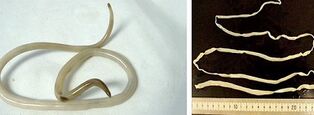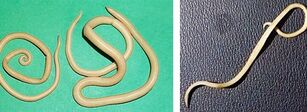
As you know, parasites are considered to be the most resistant organisms to the external environment. To date, about 250 species are recognized as helminths capable of infecting humans. They are all for healthThere are threats, and in more severe cases - to the life of the infected. Knowledge about the types of helmanths in humans and their characteristics makes treatment much easier and helps to formulate an effective preventive plan.
What kind of insects do humans have?
It takes a lot of time to become fully familiar with the types of insects themselves. The fact is that, so far, scientists cannot provide the most detailed information on the classification of parasites. To a large extent this factBeing that a certain region is characterized by the presence of a specific helminthic invasion. In this regard, data on all types of human helminths present on Earth is nearly impossible to obtain.
Thus, insects, often diagnosed in the southern region, are practically not found in populations in northern geographic regions. For temperate climatic zones and mid latitudes, about 20 types of insects form the most common. They can be conditionally divided into 3 main categories:
- round parasitic worms (nematode).
- tape helminth (cestodes).
- Flat Worms (Threatrod).
1. Round and flat helminths
Each of the above groups includes a large variety of parasitic organisms that require a brief description. In children and adults, it is most often necessary to treat such representatives of insects of the class of trembling. :
- Chinese temp;
- kitten;
- Liver fluke.
Among the nematodes, there are 7 of the most well-known and common parasite species that inhabit bodies of any age. Roundworms that are transmitted in any way are:
- pinworm;
- roundworm;
- bowel acne;
- whipworm;
- Trichinella;
- Trichostrongylides;
- hookworm.
2. cestode attack
Tapeworms (or cestodes) are parasitic worms that pose the greatest threat to the body. Children and adults are diagnosed with such helminthic infections much less frequently than round parasites, but infections with the following types of worms are most common. Filled with serious consequences:
- fast tapeworm;
- dwarf tapeworm;
- pork tapeworm;
- wide ribbon;
- Echinococcus;
- Rat tapeworm.
One of the intractable types of helminthic invasions is Acantocephalus. These include giant ridges and beaded ridges. Such insects are able to enter the body in the most infectious cases, for example, when insects infected with parasitesOr eat its larvae.
Why are insects dangerous for humans?
To adequately assess the degree of danger to a patient's health in the event of a helminth settlement, it is first necessary to determine what type of insects they are. Depending on the type of worm, the treatment and itsThe duration is determined. The main loss from the presence of parasites in the body is felt by the intestines - the major part of all helminths in this organ is localized. All nutrients must be absorbed and selected by insects to benefit a person. is.
Meanwhile, other types of insects do not settle in the intestines and "steal" all essential valuable microorganisms from humans. They actively multiply and affect other vital human organs and systems. Heart muscles. , In addition to the liver and lungs, insects can cause heavy damage to the brain and blood vessels. Worms can also infect the eyes.
main methods of worm infection

If you know that the helminths of a particular species enter the body, you can protect yourself and your loved ones from the onset of the disease. It takes all the necessary measures to timely and prevent infection. The only way to reduce the risk. It is known the main routes of transmission:
- Infection occurs through soil and water. When walking barefoot, the risk of eggs laying inside increases manifold. An unverified source of drinking and, in general cases, evenThat a normal water supply may cause worm larvae in the water.
- Helminth eggs enter the body along with animal products. Helminthic invasion results in inadequate or poor quality processing of meat, fish, seafood, eggs. People who prefer exotic Asian food are prone to worms. They are based on sushi, sashimi, raw fish and meat.
- Some types of parasites can settle in the intestine, which mix with unripe vegetables and fruits. Refusal of animal products does not solve the problem of developing helminthiasis. Worm eggs, asAs mentioned, it can be found in soil. It is recommended to pour boiling water on any fruit before use.
- Insects are transmitted from humans and animals. Pet animals often do not become a source of infection for their owners. However, insects can be found inside the animal and on its fur. From dogs and cats, parasites eggs soilFall into, spread further with melting water.
Transmission of parasites from sick people
Worms can also pass from one infected person to another. There are several ways of transmission of helminthic invasion:
- through unintentional hands (for example, when shaking hands, hugs);
- when using common utensils;
- when wearing someone else's underwear;
- Group application of personal hygiene products by many people.
Pinworm eggs most often pass from person to person, often coming under the nail plates, staying there for a long time. The prevalence of this type of worms in children is explained by the neglect of the primary rules of hygiene. A child can simply drag their hands into their mouths or bite their fingernails, so pinworms have no difficulty penetrating a new human body. Recognizing the signs of helminthiasis and preventing the development of helminthic invasion in your child immediately begins to cure the disease.
symptoms of acute phase of helminthesis
The early signs of parasitic infection in an adult or child are not easy to detect. Diagnosis of the presence of worms is also complicated by the fact that in some species the incubation period can last up to one and a half years.
As a rule, the first signs of worm infection appear after different times. In addition, the course of helminthiasis can be conditionally divided into 2 stages:

- acute phase (lasts no more than two months on average after the incubation period);
- chronic (characterized by the development of sexually mature parasites) and may last for decades.
In the acute phase of invasion, a predominantly clearly expressed symptom may be called an allergic reaction. As a result of the production of antibodies on the migration of parasitic larvae, pathological manifestations on the skin should be alerted. An indicator of infection with any type of worm is the following symptoms:
- skin hypermia;
- Burning and itching;
- small rashes on the surface of the epidermis or mucous membrane;
- slight increase in lymph nodes;
- local edema;
- pain in sternum (until suffocation attacks);
- vomiting and persistent nausea;
- diarrhea or constipation.
In addition, dangerous pathologies such as pneumonia, meningoencephalitis, hepatitis can become complications due to the presence of other creatures in the body.
A reliable confirmation of the presence of helmanthus in internal organs is the index of eosinophils in clinical blood tests. The increased value of these particles is due to dysproteinemia - a violation of the normal numerical ratio between protein fractions.
Types of symptoms in chronic form of disease
The localization of parasite colonization predetermines the signs of chronic helminthis in humans. In simple terms: The manifestations of the disease will depend on which organ will become the main habitat for a particular type of worm.
In particular, the most common parasitism in the intestines of round worms can proceed even without minor symptoms. If larger species are affected by the worms, the signs of the disease will become noticeable as the worm reaches puberty. Diaspeptic disorders, pain syndromes and neurotic manifestations in an adult and a child are their distinguishing features. Ascariasis is often characterized by the development of intestinal obstruction and pancreatitis, and there is an increased risk of oncological diseases.
drugs against parasites
It is necessary to undergo helminthysis treatment at the earliest possible stage. An effective therapy would be if you know what kind of parasites are inhabited in the body before starting it. There are plenty of antihelmathic medicines today.
These are a variety of drugs that can target a specific type of worm. Strong worm medications are broad-spectrum drugs and are excellent for the treatment of joint helminthiasis. Both are considered toxic, have a lot of side effects andThere are contraindications. The use of such drugs should be done with extreme caution only after medical advice.
Most types of worms in an adult have to be treated long and continuously. Often, parasitologists prescribe simultaneous administration of several antihelminthic drugs.
The diet and dosage of a particular drug should be specially formulated by a specialist. This will help avoid allergies and serious side effects. For some types of helminthic infections, treatment should be repeated. This is often the fact. Most adult worms were neutralized during the first therapy, but some forms of larvae and worm eggs still remain in the patient's body. If left untreated, the worms will return again. .
Basic Prevention Measures
Drug therapy is undoubtedly an important part of the process of getting rid of, and in some cases, parasite prevention. However, to deal with invasive worms, it is necessary to follow the simplest rules to prevent worms. If youIf the following rules are ignored, the treatment will not work:
- Wash hands frequently, after using the toilet and before eating.
- If you cannot clean your hands with soap, it is advisable to use wet antibacterial wipes.
- Any food should be washed thoroughly before cooking.
- It is important to expose meat and fish to prolonged heat exposure.
- Use only water from reliable sources for drinking.
- It is extremely important to be tested for worms, at least once a year.


















































